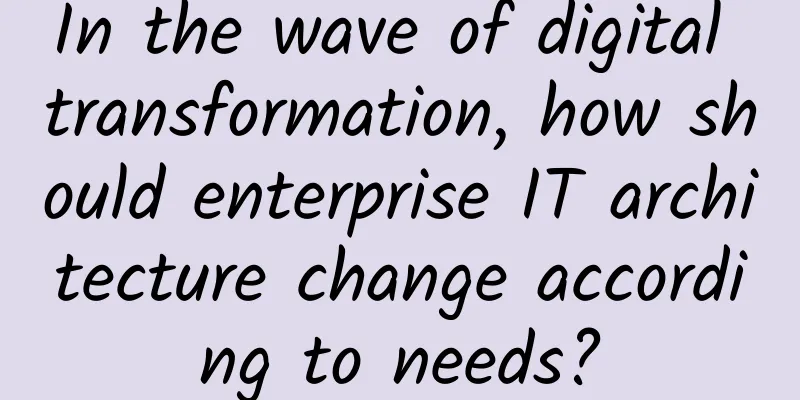In the wave of digital transformation, how should enterprise IT architecture change according to needs?

|
The wave of digitalization is driving the world economy to achieve rapid development. All industries are actively implementing digital strategic transformation to create more value. IT has become a huge industry, with a global scale of $4 trillion to $4.5 trillion, accounting for about 5-6% of the global GDP (84 trillion) in 2020. In this context, traditional IT architecture can no longer meet the needs of enterprises for rapid change and development, and is no longer adaptable to the challenges brought by digitalization. A new architecture is urgently needed to help enterprises achieve innovation by optimizing business and technology. Looking at the digital transformation development process of enterprises, it can be divided into three stages: the first stage is task automation. In this stage, by introducing applications into business processes, complex manual tasks are turned into automated execution to improve efficiency. The second stage is digital expansion. In this stage, as enterprises begin to use cloud-native infrastructure and software development to achieve automation, a new generation of applications will achieve digital expansion, so that the entire enterprise end-to-end process can be completed through digitalization. The third stage is artificial intelligence-assisted business. Entering this stage, as the digitalization process of enterprises deepens, application platforms, telemetry technology, data analysis, machine learning (ML) and artificial intelligence technology will be integrated into the business processes of enterprises, and artificial intelligence will be used to assist business and thus improve the productivity of enterprises. Six technical capabilities required to achieve digital transformation F5's global executive vice president, chief technology officer and chief Chinese scientist Geng Lin said that these three stages also show a general process of digital transformation, which introduces some new capabilities for every enterprise's IT capabilities and architectural changes. Among these capabilities, six are essential for enterprise transformation. They include: IT infrastructure capabilities. Today's enterprise IT infrastructure is providing system, network and storage resources in data centers, clouds and edge environments in a unified and more efficient way. It is no longer fixed or static, but based on dynamic and distributed concepts, providing resource elasticity to support other infrastructure environments; security. Traditional binary security strategies based on rigid IT architecture will no longer serve the business, and may even become an obstacle to enterprise development. Therefore, enterprises need to find the necessary balance between security and performance in risk strategies; data. Enterprises need to expand data to break the data island effect, including using telemetry technology to collect real-time operational data, executing new strategies to provide more accurate and keen insights, and promoting automation and decision-making. Application distribution and delivery. With the increasing pressure to improve performance and users' expectations for digital experience, enterprises need to provide applications and digital services to meet challenges. This will inevitably put application delivery on the technical agenda in order to distinguish it from the infrastructure traditionally associated with it; observability and automation, observability injects the digital enterprise with the signals it needs (i.e. data) so that it can make adjustments with minimal human intervention (i.e. automation); SRE (site reliability engineering) practices, SRE fills the need for data-based digital business operations, by leveraging automation and focusing on meeting SLOs linked to business outcomes rather than purely technical measures. F5 Global Executive Vice President and Chief Technology Officer, Chief Chinese Scientist Geng Lin Empowering enterprise customers with six technical capabilities Among these six technical capabilities, F5, as a company focusing on multi-cloud application security and application delivery service technologies, has strong strengths in application distribution and delivery, application security, observability, and automation. In the application delivery product line, BIG-IP and NGINX can help enterprises complete application distribution and delivery. The byproducts of these two product lines can bring observability and automation to enterprises. In terms of security, F5 has products such as BIG-IP, WAF, API protection, DevOps protection, etc. After acquiring Shape, F5 will increase its research and development efforts in robot attacks, protection, Bot protection, traffic fraud, and end-user protection. At the platform level, through the acquisition of Volterra, F5 can provide a distributed cloud platform to help enterprises complete multi-cloud distributed connections. In business scenarios, F5 Distributed Cloud provides edge-based products, including WAF, API protection, etc. Changes in strategic layout, team capabilities or management model In addition to technical capabilities, enterprises also need to make adequate preparations in terms of strategic layout, team capabilities or management models when undergoing digital transformation. Lin Geng gave a detailed introduction to this. The first is the change in the technical capabilities of personnel. As enterprises go deeper into digital transformation, the requirements for the technical capabilities of personnel are increasing. Take the banking industry as an example. In the past, the talents needed by the banking industry were mostly professionals in the financial industry. With the transformation of technology, in addition to professionals with a financial background, there is an increasing demand for data scientists and digital security talents. The second is the change in processes. Nowadays, online banking and mobile banking are increasingly used, and online and offline businesses are increasingly integrated. The backend architecture and business processes of banks must change accordingly. The third is that the organizational structure of the entire enterprise will change. In the digital age, some new leadership positions will emerge, such as the Chief Digital Officer. In the traditional banking industry in the United States, the general organizational structure is organized according to revenue, and many branch banks are managed uniformly, and all business flows are completed through branch banks. For other businesses, such as credit cards, there will also be a CEO responsible for the credit card business. In short, its organizational structure is built according to revenue channels. With the digital transformation, most of the banking business will eventually be powerful applications and digital services, and various channels are just ways to complete digital services, so the organizational structure of the enterprise should be changed from vertical to horizontal, focusing more on what kind of digital services the enterprise should provide. Authoritative data shows that 2023 will be the first year that digital technology consumption exceeds traditional technology consumption, so all industries are about to enter the digital-first stage. As a result, at the technical level, 50% of the personnel will have digital technology capabilities, and the subsequent business processes will be more customized, designed, and optimized digital transformation processes, and the organizational structure will be digital-first oriented. Conclusion Digital transformation has become the main theme of corporate strategic transformation. However, if companies want to use digital transformation to lead change and achieve innovation, they also need to develop customized transformation strategies that suit their own characteristics based on their own technical capabilities, and then prepare in terms of talent, processes, architecture, etc., to build six major technical capabilities in IT infrastructure, security, data, application distribution and delivery, observability and automation, and SRE practice. With the power of digital technology, we can reshape the technical foundation, improve user experience, and create more value. |
<<: Advantages of 5G networks and the main problems they face
>>: Soul-searching question for TCP: Are you going to surrender?
Recommend
Huawei's "Government Cloud China Tour" arrives in Shaanxi
In the near future, mankind will once again usher...
Let’s talk about 6G development
As of now, the fifth generation (5G) mobile commu...
Application scenarios are becoming increasingly diversified, and my country is accelerating the development of blockchain technology
my country has the world's largest Internet a...
Zhang Xuezhi from the Ministry of Industry and Information Technology: We will continue to support all parties in the industry to jointly promote the development of 5G applications
[[411408]] From July 13 to 15, the 2021 China Int...
It is necessary to draw a clear line between the capital push and capital speculation behind blockchain
In recent days, the most eye-catching and frequen...
Understand RFID technology in one article! 3 types, 6 fields, 7 major advantages
Why can our express deliveries always be accurate...
DesiVPS launches NVMe hard drive series Los Angeles VPS starting from $20 per year
DesiVPS sent a new email saying that it has launc...
[5G Encyclopedia] The mysterious relationship between parameter sets and numerology
When I first saw the word "Numerology" ...
The world's first batch of 5G-enabled Wi-Fi hotspots are here
There is no need to wait until 2020. Now the worl...
5G private network spectrum allocation controversy: not black and white, but efficiency first
Recently, the French government announced that in...
The Experience Economy is in Full Swing: Aruba Drives the Intelligent Digital Workplace
Under the wave of mobility and digitalization, th...
Knowledge Popularization | 7 Deployment Solutions for 5G Private Networks
[[315546]] What is 5G private network? 5G private...
Gigabit broadband, who will buy it?
From the second half of last year to this year, t...
Spectrum is scarce and expensive. Should 2G be retained or abandoned? This is a big question that operators need to consider.
According to foreign media reports, in just a few...
Behind Baidu’s keyword search: Be aware of fraud risks and borrowing costs being raised in disguise?
[[387830]] Has Baidu failed to fulfill its duty i...







![[Black Friday] RAKsmart: San Jose servers start at $30/month, Los Angeles servers start at $60/month, Japan servers start at $99/month](/upload/images/67cac494a247b.webp)

